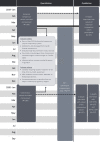Mixed-method study to assess the feasibility, acceptability and early effectiveness of the Hospital to Home programme for follow-up of high-risk newborns in a rural district of Central Uganda: a study protocol
- PMID: 33653756
- PMCID: PMC7929893
- DOI: 10.1136/bmjopen-2020-043773
Mixed-method study to assess the feasibility, acceptability and early effectiveness of the Hospital to Home programme for follow-up of high-risk newborns in a rural district of Central Uganda: a study protocol
Abstract
Introduction: A follow-up programme designed for high-risk newborns discharged from inpatient newborn units in low-resource settings is imperative to ensure these newborns receive the healthiest possible start to life. We aim to assess the feasibility, acceptability and early outcomes of a discharge and follow-up programme, called Hospital to Home (H2H), in a neonatal unit in central Uganda.
Methods and analysis: We will use a mixed-methods study design comparing a historical cohort and an intervention cohort of newborns and their caregivers admitted to a neonatal unit in Uganda. The study design includes two main components. The first component includes qualitative interviews (n=60 or until reaching saturation) with caregivers, community health workers called Village Health Team (VHT) members and neonatal unit staff. The second component assesses and compares outcomes between a prospective intervention cohort (n=100, born between July 2019 and September 2019) and a historical cohort (n=100, born between July 2018 and September 2018) of infants. The historical cohort will receive standard care while the intervention cohort will receive standard care plus the H2H intervention. The H2H intervention comprises training for healthcare workers on lactation, breast feeding and neurodevelopmentally supportive care, including cue-based feeding, and training to caregivers on recognition of danger signs and care of their high-risk infants. Infants and their families receive home visits until 6 months of age, or longer if necessary, by specially trained VHTs. Quantitative data will be analysed using descriptive statistics and regression analysis. All results will be stratified by cohort group. Qualitative data will be analysed guided by Braun and Clarke's thematic analysis technique.
Ethics and dissemination: This study protocol was approved by the relevant Ugandan ethics committees. All participants will provide written informed consent. We will disseminate through peer-reviewed publications and key stakeholders and public engagement.
Trial registration number: ISRCTN51636372; Pre-result.
Keywords: community child health; health policy; neonatal intensive & critical care; quality in health care.
© Author(s) (or their employer(s)) 2021. Re-use permitted under CC BY-NC. No commercial re-use. See rights and permissions. Published by BMJ.
Conflict of interest statement
Competing interests: None declared.
Figures
Similar articles
-
Feasibility, acceptability and preliminary effectiveness of the Hospital to Home discharge and follow-up programme in rural Uganda: a mixed-methods intervention study.BMJ Glob Health. 2025 Feb 12;10(2):e015945. doi: 10.1136/bmjgh-2024-015945. BMJ Glob Health. 2025. PMID: 39939110 Free PMC article.
-
Randomised controlled pilot feasibility trial of an early intervention programme for young infants with neurodevelopmental impairment in Uganda: a study protocol.BMJ Open. 2019 Oct 9;9(10):e032705. doi: 10.1136/bmjopen-2019-032705. BMJ Open. 2019. PMID: 31601606 Free PMC article.
-
Cue-based versus scheduled feeding for preterm infants transitioning from tube to oral feeding: the Cubs mixed-methods feasibility study.Health Technol Assess. 2021 Dec;25(74):1-146. doi: 10.3310/hta25740. Health Technol Assess. 2021. PMID: 34878383
-
The future of Cochrane Neonatal.Early Hum Dev. 2020 Nov;150:105191. doi: 10.1016/j.earlhumdev.2020.105191. Epub 2020 Sep 12. Early Hum Dev. 2020. PMID: 33036834
-
Folic acid supplementation and malaria susceptibility and severity among people taking antifolate antimalarial drugs in endemic areas.Cochrane Database Syst Rev. 2022 Feb 1;2(2022):CD014217. doi: 10.1002/14651858.CD014217. Cochrane Database Syst Rev. 2022. PMID: 36321557 Free PMC article.
Cited by
-
Acceptability to donate human milk among postnatal mothers at St. Francis hospital Nsambya, Uganda: a mixed method study.Int Breastfeed J. 2024 Feb 1;19(1):9. doi: 10.1186/s13006-024-00615-2. Int Breastfeed J. 2024. PMID: 38303077 Free PMC article.
-
Training programs to improve identification of sick newborns and care-seeking from a health facility in low- and middle-income countries: a scoping review.BMC Pregnancy Childbirth. 2021 Dec 14;21(1):831. doi: 10.1186/s12884-021-04240-3. BMC Pregnancy Childbirth. 2021. PMID: 34906109 Free PMC article.
-
Feasibility of implementing family-integrated newborn care for hospitalised preterm and low birthweight infants in newborn care units of Ethiopia: a mixed-methods design.BMJ Open. 2025 Jan 21;15(1):e093377. doi: 10.1136/bmjopen-2024-093377. BMJ Open. 2025. PMID: 39842933 Free PMC article.
-
Neurodevelopmental screening for neonates less than 44 weeks gestation in low-income and middle-income countries: a systematic review.BMJ Glob Health. 2025 Apr 2;10(4):e017683. doi: 10.1136/bmjgh-2024-017683. BMJ Glob Health. 2025. PMID: 40180429 Free PMC article.
-
Implementation of Hospital-to-Home Model for Nutritional Nursing Management of Patients with Chronic Kidney Disease Using Artificial Intelligence Algorithm Combined with CT Internet.Contrast Media Mol Imaging. 2022 Mar 27;2022:1183988. doi: 10.1155/2022/1183988. eCollection 2022. Contrast Media Mol Imaging. 2022. PMID: 35414801 Free PMC article. Clinical Trial.
References
-
- Hug L, Sharrow D, Zhong K. Levels & trends in child mortality report 2018. New York: United Nations Children’s Fund, 2018.
Publication types
MeSH terms
Associated data
Grants and funding
LinkOut - more resources
Full Text Sources
Other Literature Sources
Medical


